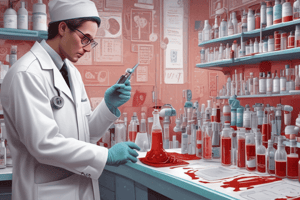Podcast
Questions and Answers
Which of the following tests is used to determine the percentage of red blood cells within a volume of blood?
Which of the following tests is used to determine the percentage of red blood cells within a volume of blood?
- Packed cell volume (PCV) (correct)
- Complete blood count
- Hemoglobin level
- Platelet count
Which of the following carries oxygen from the lungs to the rest of the body using a special protein called hemoglobin?
Which of the following carries oxygen from the lungs to the rest of the body using a special protein called hemoglobin?
- Platelets
- White blood cells
- Plasma
- Red blood cells (correct)
What is the normal packed cell volume (PCV) percentage for dogs?
What is the normal packed cell volume (PCV) percentage for dogs?
40 to 59 percent
Which of the following is also referred to as erythrocytes?
Which of the following is also referred to as erythrocytes?
Which of the following is also referred to as leukocytes?
Which of the following is also referred to as leukocytes?
The liquid portion of blood which plays an important role in transportation throughout the body is known as which of the following?
The liquid portion of blood which plays an important role in transportation throughout the body is known as which of the following?
If an animal has been diagnosed with polycythemia, which of the following symptoms typically occurs?
If an animal has been diagnosed with polycythemia, which of the following symptoms typically occurs?
Which of the following has the major role of defending the body from organisms such as bacteria, viruses, and fungi?
Which of the following has the major role of defending the body from organisms such as bacteria, viruses, and fungi?
How long does the average red blood cell live?
How long does the average red blood cell live?
In cattle, which of the following is the best location to obtain a small blood sample?
In cattle, which of the following is the best location to obtain a small blood sample?
According to Jenna Barber, DVM, which vein can be utilized when drawing blood from a cat but NOT from a dog?
According to Jenna Barber, DVM, which vein can be utilized when drawing blood from a cat but NOT from a dog?
What part of the body produces platelets?
What part of the body produces platelets?
Which of the following types of white blood cells are NOT formed in bone marrow?
Which of the following types of white blood cells are NOT formed in bone marrow?
Where is the best location to obtain a large blood sample from a horse?
Where is the best location to obtain a large blood sample from a horse?
After an injury, what happens to platelets?
After an injury, what happens to platelets?
Flashcards
Packed Cell Volume (PCV)
Packed Cell Volume (PCV)
A test that measures the percentage of red blood cells in a blood sample. It's like checking the ratio of red cells to the total blood volume.
Red Blood Cells
Red Blood Cells
Tiny, disc-shaped cells responsible for carrying oxygen throughout the body. They contain a protein called hemoglobin, which binds to oxygen.
Dog's Normal PCV
Dog's Normal PCV
The normal range for red blood cells in a dog's blood sample, usually between 40% and 59%.
Erythrocytes
Erythrocytes
Signup and view all the flashcards
Leukocytes
Leukocytes
Signup and view all the flashcards
Plasma
Plasma
Signup and view all the flashcards
Polycythemia
Polycythemia
Signup and view all the flashcards
White Blood Cells
White Blood Cells
Signup and view all the flashcards
Red Blood Cell Lifespan
Red Blood Cell Lifespan
Signup and view all the flashcards
Caudal Tail Vein
Caudal Tail Vein
Signup and view all the flashcards
Medial Saphenous Vein
Medial Saphenous Vein
Signup and view all the flashcards
Platelets
Platelets
Signup and view all the flashcards
Lymphocytes
Lymphocytes
Signup and view all the flashcards
Jugular Vein
Jugular Vein
Signup and view all the flashcards
Platelet Action After Injury
Platelet Action After Injury
Signup and view all the flashcards
Study Notes
Blood Sample Analysis
- Packed Cell Volume (PCV) measures the percentage of red blood cells in blood.
- Red blood cells transport oxygen throughout the body, utilizing the protein hemoglobin.
- Normal PCV range for dogs is between 40% and 59%.
- Red blood cells are also known as erythrocytes.
- White blood cells are referred to as leukocytes, playing a crucial role in immune defense.
- Plasma is the liquid component of blood, essential for transportation of nutrients and waste.
- Polycythemia may result in symptoms like diarrhea in affected animals.
- White blood cells defend against pathogens such as bacteria, viruses, and fungi.
- The lifespan of an average red blood cell is approximately 100 days.
Blood Draw Techniques
- The caudal tail vein is the preferred site for obtaining small blood samples from cattle.
- The medial saphenous vein can be used for blood collection from cats, but not from dogs.
- Platelets are produced in the bone marrow, contributing to clot formation.
- Lymphocytes, a type of white blood cell, are not formed in bone marrow; they develop in lymphoid tissue.
- The jugular vein is the optimal location for collecting large blood samples from horses.
- Following an injury, platelet levels increase, facilitating blood clotting and healing.
Studying That Suits You
Use AI to generate personalized quizzes and flashcards to suit your learning preferences.




